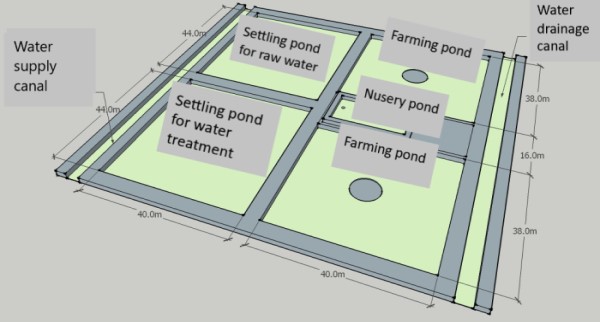Super-intensive whiteleg shrimp farming in 2 stages and little water change according to Truc Anh Technology
Translated from TBKT 03-01: 2017/BNNPTNT; issued together with Decision No. 502/QD-TCTS-KHCN & HTQT in May 3, 2017 by the Directorate of Fisheries of Vietnam.
Note: Due to extensive content of the original document, this article is summarized by Viet Linh.
I/ GENERAL BACKGROUND OF THIS TECHNOLOGY
1/ Author: Le Anh Xuan, MSc.
2/ Organization: Truc Anh Production and Trading Co., Ltd.
- Address: 1/415, Cong Dien Hamlet, Vinh Trach, Bac Lieu City, Bac Lieu Province, Vietnam.
3/ Foundation of this technology:
Results of a scientific and technological study named "Research on building a two-stage super-intensive whiteleg shrimp (Litopenaeus vannamei) farming model with the application of biofloc technology" implemented by Truc Anh Production and Trading Co., Ltd. in 2015 and 2016.
4/ Participants: Organizations and individuals applying intensive whiteleg shrimp farming in two stages with little water exchange.
5/ Scope of application: Intensive shrimp-farming areas.
6/ Stages of application:
a) The nursery phase of shrimp breed (phase 1):
- Nursery density: 1,000 - 3,000 shrimp/square meter;
- Nursery size: PL10 - 12;
- Nursing time: from 20-25 days when shrimp reach a weight of 1,000-2,000 shrimp/kilogram;
- Survival rate: 90-95%.
b) The commercial shrimp-farming phase (phase 2):
- Breeding density: 100 - 300 shrimp/square meter;
- Shrimp post-larvae size: 1,000 - 2,000 shrimp/square meter;
- Duration of farming: 65 - 80 days;
- Size of shrimp for harvest: 40 - 60 shrimp/kilogram;
- Productivity: 34 - 40 tons/hectare;
- Survival rate: 90 - 95%.
II/ FARMING PROCESS
1/ Design of farming system
A shrimp farm is designed as shown in Figure 1. The farm should include 1 settling pond for raw water, 1 settling pond for water treatment, 1 nursery pond, 2 farming ponds, 1 water supply canal, 1 water drainage canal, along with an area for waste water storage and auxiliary works.

Figure 1. Design of pond system for shrimp farming in an area of 1 hectare
Note:
- Settling pond for raw water (1st settling pond): pump raw water from supply ditch into this pond through a tube with double-layer filter bag. This settling pond is used for water storage and natural cleaning to minimize pathogens from raw water pump from supply ditch. The pond is arranged next to the water supply ditch with a depth of 2-3 meters (depending on soil conditions). It should have an area of about 20% of the total area of the farm.
- Settling pond for water treatment (2nd settling pond): pump water from the 1st settling pond into this pond through a tube with a double-layer filter bag. Similar to the 1st settling pond, this pond is used for water storage and natural cleaning to minimize pathogens from the natural water supply source. This settling pond should be arranged next to the 1st settling pond. It also needs to be lined with canvas (if possible), with the same area and depth as the 1st settling ponds.
- Nursery pond: pump water from the 2nd settling pond to this nursery pond through a tube with a double-layer filter bag. This pond is used to nurse shrimp post larvae from PL10 to PL12 period until shrimp reach the size of 1,000-2,000 shrimp/kilogram. Nursery pond needs to be located next to the 2nd settling pond with a depth of 1.5-1.8 meters (depending on soil conditions). Pond bottom should be designed to be equal to pond surface with systems for shrimp transfer, pond bottom oxygen, aeration, and shade net. This pond needs to be lined with canvas at banks and bottom of the pond. The area of nursery pond accounts for about 5% of the total farm area, or 10% of one farming pond.
- Farming pond: pump water from the 2nd settling pond to this pond through a tube with a double-layer filter bag. Farming pond is used for commercial shrimp farming. The pond should be located next to the nursery pond and not too far from the 2nd settling pond. Farming pond needs to have a depth of 1.5-2.0 meters (depending on soil conditions). It should be lined canvas at the bottom of the pond and banks. It must have systems for siphon, pond bottom oxygen, aeration, and an automatic feeding machine (if any). The area of farming accounts for about 30% of the total farm area (area of each pond may range from 1,000-6,000 square meters).
- Aeration system: should be installed at 1.5-2.0 meters from pond edges. The distance between two sets of paddle wheels is 50-60 centimeters; blades should be staggered. The number of paddle wheels depends on the density and type of paddle wheels (see instructions in Table 1).
|
Number of paddle wheels |
Oxygen diffuser disc, or diffuser aero tube |
Note |
100-150 |
4 set (10 paddle wheels/set) |
50-70 |
- The speed of paddle wheels should be from 100 - 120 rpm. |
150-200 |
4 set (15 paddle wheels/set) |
80-120 |
|
200-250 |
4 - 6 set (15 paddle wheels/set) |
120-200 |
|
250-300 |
4 - 6 set (15 paddle wheels/set) |
200-250 |
Table 1. Guidelines for using the number of paddle wheels for ponds (applicable to ponds with an area of 2,000-3,000 square meters each).
© 2019 Viet Linh
- Shrimp farming during tropical depressions
- Aquaculture in rainy and flood season
- Some tips for shrimp farming with biofloc and semi-biofloc technology
- Tags: whiteleg shrimp; super intensive farming; shrimp; shrimp farming